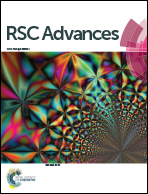A rechargeable sodium-ion battery using a nanostructured Sb–C anode and P2-type layered Na0.6Ni0.22Fe0.11Mn0.66O2 cathode
Abstract
Herein we report the realization and characterization of a full sodium-ion cell using a P2-Na0.6Ni0.22Fe0.11Mn0.66O2 layered oxide positive electrode (cathode) and a nanostructured Sb–C alloying negative electrode (anode). X-Ray Diffraction (XRD), Scanning Electron Microscopy (SEM) and transmission electron microscopy (TEM) reveal the well-defined layered-structure of the cathode and the presence of nanometric antimony trapped within the carbon matrix of the anode. The optimized materials structures allow enhanced performance of each electrode in cells with sodium metal anodes, as revealed by electrochemical characterization including cyclic voltammetry (CV) and galvanostatic cycling (GC), further improved by the addition of fluoroethylene carbonate (FEC) into the electrolyte. Finally, the performance of the rechargeable Sb–C/Na0.6Ni0.22Fe0.11Mn0.66O2 sodium-ion battery using the FEC-added electrolyte solution is reported. Such a cell shows an average working voltage of about 2.7 V while delivering a stable capacity of about 120 mA h g−1, leading to a theoretical energy density of about 300 W h kg−1, based on the cathode weight. The expected practical energy of industrial cells based on this chemistry, calculated using the 1/3 reduction factor accounting for inactive components and packaging as derived from Li-ion batteries, is about 100 W h kg−1, which is to be considered to be an extremely promising value.


 Please wait while we load your content...
Please wait while we load your content...